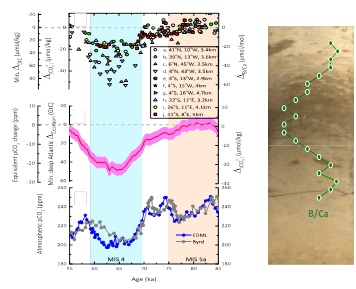In the past 150 years, atmospheric carbon dioxide (CO2) has risen from around 300 parts per million to 400 parts per million. It is ongoing debated whether current growth in atmospheric CO2 is blamed for global warming or not. To improve our understanding of climate change in the future we must look at what happened in the past.
During the slide into an ice age about 70,000 years ago, it was a major climate transition period for the Earth. During 10,000 years the sea level dropped 60 metres, and the atmosphere lost 60 gigatonnes of carbon, equivalent to a drop of about 30 parts per million of CO2, but its underlying causes remain enigmatic.
A research team led by Dr YU Jimin from The Australian National University (ANU), including the team member of Professors JIN Zhangdong and CAI Yanjun and Dr ZHANG Fei from Institute of Earth Environment of Chinese Academy of Sciences (IEECAS), and other partner institutions studied the chemical makeup in fossils of tiny animals called benthic foraminifera that live in the deepest parts of the Atlantic Ocean.
The team found that a huge reservoir of carbon developed in the deep Atlantic Ocean during the last ice age recorded by the decreased ratios of boron to calcium in the fossils that reflect an increase in the amount of CO2 in the ocean more than three kilometres under the surface. The research has found as ocean currents changed over 10,000 years, an extra 50 gigatonnes of carbon was stored at the bottom of the Atlantic Ocean. The change in CO2 matched closely with changes in the ocean circulation, which led to a large body of carbon-laden water in the Southern Atlantic to spread northward and upward. The deep ocean water originating from the South Atlantic stayed at the bottom of the ocean for hundreds of years accumulating carbon from the dead plankton sinking from the surface. The research will help scientists understand (1) the fate and the impact of that carbon and (2) the complex interactions between the atmosphere and the ocean.
The research is published as an Article in Nature Geoscience on February 8, 2016 (Citation: Yu J M, Menviel L, Jin Z D, Thornalley D J R, Barker S, Marino G, Rohling E J, Cai Y J, Zhang F, Wang X, Dai Y, Chen P, Broecker W S. Sequestration of carbon in the deep Atlantic during the last glaciation. Nature Geoscience, 2016, doi: 10.1038/ngeo2657).

Fig.1. Deep Atlantic carbon budget across the MIS 5-4 transition (Yu et al., 2016, Nature Geoscience). During transitions into cold climate, storage of carbon in the deep ocean lowers deep water pH and causes carbonate dissolution on seafloor (dark color) (Right). Chemical compositions of micro fossils helps quantify deep-sea carbon sequestration.
Futher Details: Dr. YU Jimin, jimin.yu@anu.edu.au. Research School of Earth Sciences, The Australian National University, Canberra, Australian Capital Territory 2601, Australia
 © 2015 Institute of Earth Environment,CAS
© 2015 Institute of Earth Environment,CAS  © 2015 Institute of Earth Environment,CAS
© 2015 Institute of Earth Environment,CAS